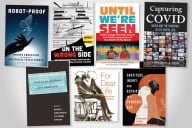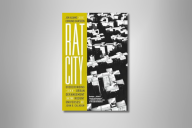You have /5 articles left.
Sign up for a free account or log in.
Scholarly presses were a modest presence at Book Expo America, the annual trade show for the publishing industry, which wrapped up its business on Sunday afternoon after three days in New York City.
More than 2,000 companies had booths in the exhibit halls. Only a few dozen were sponsored by university presses or commercial houses specializing in academic titles. Corporate publishers often showed their wares in miniature pavilions – impressive command centers, staffed by a dozen or more people, with large piles of free books and promotional knickknacks for visitors. By contrast, scholarly presses offered catalogs and the occasional bowl of tiny candy bars. None of the publicists were dressed as life-sized cartoon characters.
Despite differences in budget and scale, however, they shared something in common with other publishers working the floor at the Javits Convention Center. A few days of intensive, informal meetings can affect the business publishers do for months to come – indirectly shaping how millions of readers hear about new books.
“This is the first time we’ve had a booth at Book Expo,” said Sue Havlish, marketing director for Vanderbilt University Press, late Saturday afternoon. “But it’s been very busy so far. I’ve been talking with buyers for the big chains and independent booksellers, and with librarians and reviewers.” Some of those meetings were scheduled well before the show opened. But most, she says, were the result of foot traffic.
Naturally Book Expo is when academic imprints push their potential “crossover” books: the titles they hope will appeal to a wider audience than the niche that exists for most monographs.
This year marks the 20th anniversary of a book by a little-known (to the general public) philosopher that the Simon & Schuster expected to have a press run of a few thousand copies at most. As it turned out, Allan Bloom’s The Closing of the American Mind proved to be a bona fide best-seller. For people in academic publishing, another case is almost as legendary: a volume from Johns Hopkins University Press called Staying Dry: A Practical Guide to Bladder Control (1989).
It may not have set the nation’s cultural agenda. But thanks to a plug from advice columnist Ann Landers, the book sold more than 150,000 copies and it remains in print. That kind of crossover success helps make the publication of less commercial titles possible.
During Book Expo, Inside Higher Ed conducted a roving, ad hoc survey of scholarly publishers about their hopes for next year’s breakout books.
Before summarizing some of the trends, it’s worth noting how much the meaning of the expression “crossover” varies from press to press. For some, it might be a book so topical and trend-setting that the author is interviewed on “The Daily Show” or reviewed in The New York Times. (Publicists have a wistful look when mentioning this possibility.) But other publishers think of a monograph as having crossed over if enough professors find it worthwhile for course adoption.
Somewhere in between, there are titles that create word-of-mouth and so, in effect, sell themselves. The fall list for Duke University Press contains numerous works of terrifying erudition, such as Carl Schmitt’s magnum opus Constitutional Theory. But when flipping through the catalog with a reporter, a publicist points out that there is an unusually strong early buzz about a less prominent title, Undead TV: Essays on Buffy the Vampire Slayer (table of contents here).
“At first I didn’t know what to make of it,” the publicist says, “since there are already several academic books about ‘Buffy.’” Although the show has been off the air for four years, its fans seem to have an insatiable craving for analysis. “We’re still getting queries from people who want to know when it will be out,” she says. (The answer is November.)
With the 2008 presidential campaign off to an all-time early start, many presses are hoping to cash in with political books. Franklin Foer and the editors of The New Republic will offer essays on the candidates and issues in Election 2008: A Voter’s Guide (Yale University Press, Jan.). The team of four political scientists who report on their research in Campaign Advertising and American Democracy (Temple University Press, November) conclude that political ads “may actually educate, engage, and mobilize American voters.”
Any Democrats who are still gloating over last fall’s midterm results might want to avoid The Conservative Ascendancy: How the G.O.P. Right Made Political History (Harvard University Press, November) by Donald T. Critchlow, a professor of history at Saint Louis University, who looks at the movement’s long-term resiliency. The book will be advertised not only in major political magazines but through the Conservative Blog Network. In Allies for Armageddon: The Rise of Christian Zionism (Yale, November), British journalist Victoria Clark examines the strong support for Israel on the religious right.
The Truth About Patriotism (Duke, July) – at least according to Steven Johnston, an associate professor of government and international affairs at the University of South Florida – is that is corrodes democracy by fostering national narcissism. It sounds as if George McKenna, a professor emeritus of government at the City University of New York, may be no less critical in The Puritan Origins of American Patriotism (Yale, September)
One title guaranteed to excite attention among programmers of cable TV news program is Leaderless Jihad: Terror Networks in the Twenty-First Century (University of Pennsylvania Press, December), a study of how Internet-based forums are used to recruit and radicalize young potential jihadis. The author, Marc Sageman, is a forensic psychiatrist and senior fellow at the Foreign Policy Research Institute, a right-leaning think-tank based in Philadelphia.
In A Call for Heresy: Why Dissent is Vital to Islam and America (University of Minnesota Press, September), Anouar Majid, a professor of English at the University of New England, places the Muslim philosopher Averroes and the American revolutionary Thomas Paine on the same side of a clash with their respective fundamentalisms.
Possibly much more controversial will be Treacherous Alliance: The Secret Dealings of Israel, Iran, and the United States (Yale, October) by Trita Parsi, president of the National Iranian Council and adjunct professor at the School of Advanced International Studies of Johns Hopkins University. Parsi will reportedly document some little-known episodes in the history of U.S. relations with the two non-Arabic countries of the Middle East. His most eye-opening claim is that the Iranian government was prepared to withdraw support from Hamas and Hezzbollah until that plan was foiled by the U.S.
No surprise that plenty of titles discuss the continuing effects of 9/11 and the Iraq war, including Top Secret: When Our Government Keeps Us in the Dark (Rowman & Littlefield, September) by Geoffrey R. Stone, a former dean at the University of Chicago Law School.
But a number of offerings this fall emphasize a different political topic: the state of American health care. “Is this finally the year we have a real national discussion on health care?” asks the catalog copy for Rx for Health Care Reform (Vanderbilt University Press, September) by Ken Terry, a senior editor of Medical Economics Magazine. Laurence J. Kotlikoff, a professor of economics at Boston University, offers his own proposed solution in The Healthcare Fix: Universal Insurance for All Americans (MIT Press, October).
One of the more striking cases of a breakthrough book since last fall has been Convergence Culture: Where Old and New Media Collide, by Henry Jenkins, director of the comparative media studies program at MIT. Since New York University Press published it in August, it has run through five or six printings, according Fredric Nachbaur, who says he lost track at some point. “I do know it has been our best-selling title on Amazon for the past three months,” he says.
MIT Press might well have a similar phenomenon on its hands with Peter Ludlow and Mark Wallace’s The Second Life Herald: The Virtual Tabloid that Witnessed the Dawn of the Metaverse, due out in October. Second Life is an animated online environment that resembles a cross between virtual reality and an Internet chatroom. Most available books on it are, in effect, instruction manuals on how to create a digital persona and move around the digital “metaverse.”
But the authors (respectively, a professor of philosophy at the University of Michigan and a freelance journalist covering the videogame industry) provide something quite different: a detailed account of the strange, more or less lawless social world created by thousands of people out of pixels and fantasy.
Anxiety over the dark side of the information society might win readers for some new titles. James B. Rule, a scholar at the Center for the Study of Law and Society at the University of California at Berkeley, sees Privacy in Peril (Oxford University Press, November) while Daniel J. Solove, an associate professor of law at George Washington University, worries about The Future of Reputation: Gossip, Rumor, and Privacy on the Internet (Yale, October) And in November, New York University Press will bring out a second edition of Chained to the Desk, a guidebook for dealing with workoholics prepared by psychotherapist Bryan E. Robinson – updated from the 1998 version to deal with the special problems posed by the Blackberry and laptops with wireless.
The approaching bicentennial of Abraham Lincoln’s birth in 1809 seems like a good opportunity to earn some dead presidents. The Papers of Abraham Lincoln: Legal Documents and Cases (University of Virginia, November) will be a four-volume boxed set chronicling his work as a lawyer handling criminal and civil cases, with debt collection a specialty. Probably more appealing to History Channel-surfers is Lincoln Legends: Myths, Hoaxes, and Confabulations Associated With Our Greatest President (University Press of Kentucky, October) by Edward Steer Jr., an independent historian.
One title sure to stir up discussion is William C. Dowling’s Confessions of a Spoilsport: My Life and Hard Times Fighting Sports Corruption at an Old Eastern University (Penn State University Press, September) -- and not just around Rutgers University, where the author is a professor of English. But the needs of football fans will also be met this fall with the appearance of The Redskins Encyclopedia (Temple, September), prepared by veteran sports journalist Michael Richman. Described as “a must-have book for any fan who has ever bled burgundy and gold,” it will try to follow up on the success of The Eagles Encyclopedia, published by Temple two years ago and now in its third printing.
Trade titles such as the football encyclopedias are now indispensable to the press, explains Gary Kramer, publicity manager for Temple for the past seven years. “Those books are what permit us to bring out The Coolie Speaks,” he says, referring to a forthcoming monograph from Temple about the virtual enslavement of Chinese indentured laborers in Cuba during the 19th century. The author, Lisa Yun, is an associate professor of English and of Asian-American studies at the University of Binghamton. Kramer thinks The Coolie Speaks itself has great potential to be a crossover book. But trade titles like the reference books on football are what make it possible.
“We’ve had some dark days in the past,” he says. “We had the same problems most presses did with having a large number of returns of scholarly titles from distributors. Now we seem to have that under control and things look sunnier. The important thing is to try not to mislead yourself or your sales reps about the size of the audience for a title.”
On the other hand, he says, when it seems as if a title will have popular appeal, it’s necessary to try new approaches to marketing. “With The Eagles Encyclopedia,” he says, “we literally took it to sports bars around Philadelphia and sold boxes of it at a time.”
The trick, of course, is knowing which titles might benefit from that extra push.
At the booth for Rowman & Littlefield (a trade press with a large academic division), sales representative Scott Wythe answered a question about the possible crossover titles in the scholarly catalog by zeroing in on a specific title: Lost in the Museum: Buried Treasures and the Stories They Tell, by Nancy Moses, identified as a professional cultural development consultant. It’s a look behind the scenes at warehouses where undisplayed museum exhibits are kept.
How did he pick that title in particular? Wythe works for the Empire Group, which represents 40 relatively small publishers, including the State University of New York Press. Before his present gig, he managed an independent bookstore in Washington.
“What works for me,” he says, “is to read every word of every catalog, looking for something I haven’t seen before. Every season you find a lot of ‘me too’ books. A publisher will notice that other presses have had success with books of a certain kind, so it's time to jump on the bandwagon. You have to learn to tune that noise out and find the books that sound really new and interesting on their own merits.” He also says that listening to what booksellers have to say is part of the process, especially if they’ve noticed that a subject is beginning to generate interest among readers.
“Most of the book business is flying by the seat of your pants,” as Wythe put it halfway through the giant trade show. “It’s a matter of paying attention, seeing what works, and hoping for the best.”








